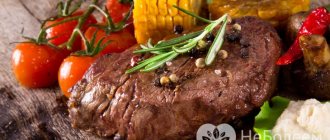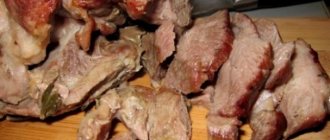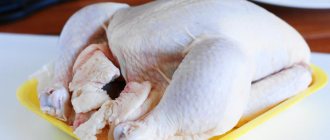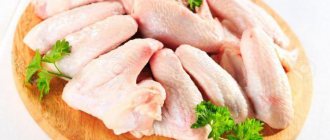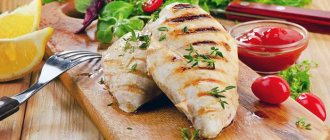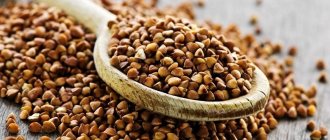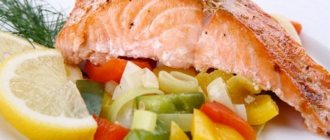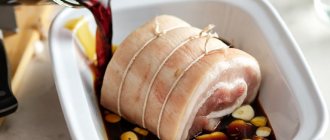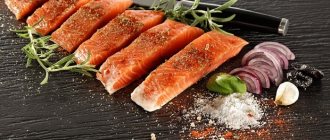Good afternoon, dear readers. The chemical composition and nutritional value of chicken meat in this material. Today’s conversation will be about chicken meat, the benefits of which make no sense to doubt, but it’s worth understanding the individual details and reasons for loving this delicacy.
There is a legendary story, based on the story about Napoleon Bonaparte, that until the age of thirty he was a desperate admirer of chicken dishes. But at one point he became an equally fierce opponent, to the point that he issued a decree to execute any court cook for serving the table with a chicken treat.
One daredevil was able to turn the situation around with his talent, and the monarch deigned to recognize him as a brilliant cook, and only he was allowed to cook chicken for the royal table. Read this link in detail about this legend.
Properties of Chicken fillet
Nutritional information |
Vitamins | Minerals How much does Chicken fillet cost (average price per 1 kg)?
Moscow and Moscow region.
135 rub.
Meat is considered one of the main food products for humans, because it helps restore muscle tissue and gives us strength. However, it is difficult to ignore the fact that meat is a fatty and high-calorie product, so the optimal solution to this issue is the inclusion of a type of meat such as chicken fillet in the diet. The calorie content of chicken fillet is relatively low, and in general, this meat is considered not only dietary, but also very nutritious. The fact is that chicken fillet contains a little fat and a significant amount of protein.
Chicken fillet should have a uniform pale pink color, a dry surface and a fresh smell.
It is best to choose chilled chicken fillet, but when purchasing you should always pay attention to the label - it can be stored for no more than 5 days
Shelf life
Calorie content of boiled chicken thigh.
chemical composition and nutritional value Chilled carcasses can be stored at temperatures from -2 to +2°C, for no more than 5 days. Chilled parts of carcasses can be stored at the same temperature, but not more than 2 days.
Frozen carcasses are stored at temperatures no higher than -12°C, -18°C, -25°C. Let's consider this point in more detail.
-12°C: if the carcasses are packaged in consumer packaging, storage can be 8 months. When packaged in a common container - no more than 4 months. Frozen parts of carcasses can be stored for no more than 1 month.
-18°C: if the carcasses are packaged in consumer packaging, storage can be 12 months. When packaged in a common container - no more than 8 months. Frozen parts of carcasses can be stored for no more than 3 months.
— 25°C: if the carcasses are packaged in consumer packaging, storage can be 14 months. When packaged in a common container - no more than 11 months. Frozen parts of carcasses can be stored for no more than 5 months.
The cost of carcasses and their parts can be found in the article: “How much does broiler chicken meat cost?”
Was the article useful to you? Please rate it 5 stars and repost. Comments are open to discuss the topic.
KFS chicken wings - how many calories are in them and are they harmful?
Calorie content of wings from KFS and McDonald's. How many calories and fat are in chicken wings, and why are they considered junk food?
Chicken wings: calories
Speaking about the calculation of KBJU and calorie content of various parts of chicken, it should be noted that many are mistaken in thinking that chicken wings from FSC contain a lot of chicken. In fact, the protein content in one wing is about 6 g. In reality, it is more correct to talk about the calorie content of the by-products, fats and breading that this wing consists of.
It is also important that the breading contains not only harmful gluten, but also a flavor enhancer, encrypted under the concept of “extracts and spices.” If we talk about the calorie content and composition of the chicken itself, then the chicken breast is indeed the lowest-fat part of the chicken. This is what makes it a dietary meat
However, without taking into account the actual composition of chicken wings from KFS or McDonald's
This is what makes it a dietary meat. However, without taking into account the actual composition of chicken wings from KFS or McDonald's.
How are chicken wings prepared?
The secret to crispy wings from a typical fast food restaurant is primarily the flour coating and caramel sauce, which contains a lot of fast carbohydrates. In addition, during preparation, mixtures of spices are used to give the most pleasant aroma, thanks to which the dish seems so unusually tasty.
In addition, bleu cheese sauce, with which chicken wings are most often served in restaurants, deserves special attention. It is made with heavy cream, cheese and vinegar, and the calorie content is approximately 20-30 kcal per teaspoon.
Chicken skin
As is quite easy to see, the most high-calorie part of the chicken is its skin, which consists of more than a third of pure fat. More than 80 percent of the calories contained in chicken skin come from animal fat. Unlike omega-3 fats, this saturated fat is harmful to health.
One gram of fat has twice the calories of one gram of carbohydrates or protein, and contains 9 calories. Our body's needs for animal fats are quite small, and most of the excess calories will go into subcutaneous fat.
Fat quality problem
It is also important that the cooking process also affects the calorie content - frying in oil will add another 20-30 calories to each wing. The calories in one large chicken wing are approximately 125 calories without the skin and 237 calories with the skin. Unfortunately, repeated use of the same oil significantly increases the risk of trans fats in it.
Unfortunately, repeated use of the same oil significantly increases the risk of trans fats in it.
KFC wings calories
Six KFC Rostix Spicy Chicken Wings contain 450 kcal, 30 g fat (half daily value), 145 mg cholesterol (half daily value), 1120 mg salt (half daily value), 23 g carbohydrates and 24 g protein.
Sometimes you can find chicken wings at McDonald's. Due to the use of a sweeter marinade, their calorie content is higher - approximately 640 kcal (serving of 4 pieces). Additionally, add about 50 calories per package of BBQ sauce. ***
Chicken wings are the highest calorie part of the chicken; in addition, the cooking method (flour breading, syrups and frying in oil) significantly increases their calorie content. A small portion (4-6 pieces) contains at least 500 kcal.
BJU in raw, boiled, smoked and fried chicken breast
Long-term nutrition programs or constant adherence to the principles of proper nutrition imply creating a menu of healthy and varied dishes. If you are tired of boiled chicken, you can fry or bake this product.
The calorie content and balance of BZHU will change, take this fact into account when selecting your diet.
| Method of preparation/KBJU | Raw | Boiled | Smoked | Fried |
| Calories, kcal | 137 | 113 | 117 | 162 |
| Amino acids, g | 24 | 28 | 18 | 25 |
| Lipids, g | 2 | 1.8 | 5 | 8 |
| Carbohydrates. G | 0.4 | 0.5 | 0.1 | 1.3 |
Raw meat contains more water, and when boiling and other cooking methods, the liquid evaporates, so the macronutrient content of cooked meals differs from raw meat.
To introduce carbohydrates and fiber into your diet, you can add vegetables to the steamer where the fillet is cooked 5 minutes before the meat is ready.
Boiled
To get the maximum benefit from boiled meat, it is better to boil it without skin, and be sure to drain the first broth.
Boiled chicken breast bju without skin per 100 g:
- 29.8 g protein;
- 1.8 g fat;
- 0.5 g carbohydrates.
Calorie content is 137 kcal.
This dish is recommended for consumption even in early childhood.
The broth obtained during the boiling process can also be consumed; its calorie content, if nothing except salt is added, is 18.8 kcal per 100 ml. In the broth, the amount of protein is reduced to 3.9 g, and fat to 0.3 g. For those who are watching their figure, the main question is how many carbohydrates are left? The smallest amount is 0.1 g.
Fried
The most high-calorie part of all chicken is the skin. If you fry without it and with a minimum amount of vegetable oil, then the chicken breast kbju will be:
- 27.61 g proteins;
- 5.0 g proteins;
- 1.03 g carbohydrates.
Nutritional value per 100 grams – 159.50 kcal or 667 kJ.
If the skin is not removed, the life expectancy will be:
- 25.3 g protein;
- 8.1 g fat;
- 1.4 g carbohydrates.
Calorie content is 177 units.
The nutritional value of cooked meat in a frying pan without oil will be only 110 kcal. But even adding herbs, lemon juice and other ingredients, you will have to calculate the calorie content separately.
This jump in energy value is due to the fact that the skin itself contains 212 kcal. Although there is a lot of controversy regarding its use. It is used to prepare sausages and stuff them with all kinds of fillings, including vegetable ones.
On the other hand, it is the skin that is considered the most dangerous part of the chicken, since in addition to its high fat content, many harmful bacteria accumulate on the surface. These microorganisms can cause an inflammatory process in the pancreas or stomach, but provided that the dish has not undergone full heat treatment.
Baked
Baking allows you to cook a very tasty chicken breast without increasing the nutritional value of the dish. It is recommended to pre-marinate the meat in brine for 3 hours to ensure a tender and not over-dried fillet. Bju dishes are:
- 19.7 g protein;
- 6.2 g fat;
- 3.6 g carbohydrates.
Nutritional value - 148.5 units per 100 g of dish, cooked in the oven in an open manner and without removing the skin.
When baked without skin or vegetable oil, the calorie content of the dish is closest to that of raw meat and equals 113 units. When baked in a sleeve, the nutritional value is 117 units.
By cooking the breast in the oven using sour cream, the calorie content of the dish will seriously increase and reach 195 kcal. When baked in foil, the nutritional value of 100 g of the dish will be 141.5 kcal. In fact, with this method of baking, the meat turns out to be stewed, and therefore juicy and soft.
Raw
In raw form, bju fillet:
- 23.6 g protein;
- 1.9 g fat;
- 0.40 g carbohydrates.
Calorie content – 113 kcal or 473 kJ.
The low calorie content of meat is indicated by its characteristic white color, which is maximally visible after heat treatment. And in order to preserve as much as possible all the beneficial substances of the breast, before cooking, chefs recommend cutting it lengthwise.
The calorie content of broiler breast is not much different from regular chicken, even given its large size. On average, nutritional value ranges from 116 to 119 units.
Grilled
Grilled chicken breast is tender and juicy. If you cook it with skin, then the yield will be:
- 29.2 g protein;
- 3.61 g fat;
- 0.21 g carbohydrates.
Calorie content – 155 units or 647 kJ. If you get rid of the skin, the nutritional value will decrease to 129.4 kcal.
By refusing to use vegetable oil, you can get a dish with a calorie content of 122.13 units. However, it is not recommended to completely abandon the use of oil, due to the fact that the pulp dries out quickly. Instead of oil, you can use sauce or marinade, which you can periodically pour over the meat during cooking. You can grill chicken breast along with vegetables. Then no additives will be required, the meat will not be dried out, as it will take moisture from the vegetables.
Calorie content and recipes for popular dishes with chicken
There are more than 500 recipes for delicious, satisfying, but easy-to-prepare dishes involving fillet. Every traditional cuisine in the world can boast of such a dish. For example, in Japan it is teriyaki and oyakodon, in India it is chicken curry, in China it is stir-fry. Even American nuggets can be prepared without compromising your figure if you replace the bread crumbs with oatmeal. Caesar with chicken
For the salad:
- 200 g chicken fillet;
- 20 lettuce leaves;
- 8 pcs. Cherry tomatoes;
- a loaf of white bread;
- 50 g parmesan or any other hard cheese;
- 1 clove of garlic;
- a pinch of salt.
For refueling:
- egg;
- 1/4 tsp. mustard;
- 1 tsp. lemon juice;
- 1 tbsp. l. olive oil;
- 3/4 tsp. Worcestershire sauce;
- a pinch of salt and pepper.
Place the egg in boiling water for 1 minute and immediately cool in cold water. Break the eggs into a bowl, add mustard, lemon juice and beat, adding olive oil and sauce, salt and pepper.
Serve the sauce separately from the salad.
Calorie content – 232.85 kcal / 100 g.
Light chicken noodle soup
- 250 g chicken fillet;
- bulb;
- carrot;
- potato;
- 100 g noodles;
- egg;
- 3 l. water;
- Bay leaf;
- salt, pepper, herbs to taste.
Fill the pan with water and put on fire. Place carrots, peeled onions, and chopped fillets in water. Bring to a boil, reduce heat and add chopped potatoes and bay leaves. Cover with a lid and cook for about 20 minutes. Add noodles, salt, pepper, break the egg and pour into the pan. Cook until the noodles are ready. Turn off and sprinkle with herbs.
The energy value of chicken and noodle soup is 77.90 kcal / 100 g.
Pilaf with chicken
- 250 g chicken fillet;
- 250 g rice;
- vegetable oil;
- carrot;
- bulb;
- cumin, salt, pepper to taste.
Grate the carrots, chop the onion finely, cut the chicken fillet into cubes. Pour oil into a deep saucepan so that it covers the bottom. Add onions, carrots and let soften. Add the chicken and stir for 3 minutes until the meat is white on all sides. Pour 2 tbsp. water, salt and pepper. Add rice, reduce heat and wait until the water evaporates. Sprinkle with cumin, cover with a lid, turn off the heat and let the rice soak.
Calorie content of pilaf with chicken – 155.94 kcal / 100 g.
Julienne with chicken and mushrooms
- 250 g chicken fillet;
- 200 g mushrooms;
- 1 onion;
- 100 g sour cream;
- 100 g cheese;
- salt pepper.
Finely chop the chicken, mushrooms and onions and mix. Make cocotte bowls from foil. Place the chicken mixture, place the onion on top, brush with sour cream and add grated cheese. Place in the oven at 180 degrees for an hour.
Calorie content – 140 kcal / 100 g.
Chicken kebab and its calorie content
- 700 g chicken thighs without skin;
- 1 liter of kefir;
- salt pepper.
Place the thighs in a bowl, pour in kefir and stir. Add spices and mix again. Place in the refrigerator overnight or for 3 hours. Kefir has the property of softening meat. Grill shish kebab on skewers or skewers.
Calorie content of chicken kebab – 225.47 kcal / 100 g.
Japanese chicken
- 500 g chicken breasts;
- 1 tbsp. l. honey;
- soy sauce;
- salt and pepper;
- sunflower oil.
Beat the chicken fillet, cut into strips and fry over high heat in vegetable oil. Add honey to soy sauce, stir, pour over chicken, salt, pepper and stir. Cover with a lid and simmer for about 5 minutes.
The energy value of Japanese chicken breasts is 107 kcal / 100 g.
Chicken oyakodon recipe
- 300 g chicken fillet;
- 1 onion;
- 1 bunch of green onions;
- soy sauce;
- 2 eggs.
Lightly pound the chicken and cut into strips. Chop the onion. Heat soy sauce in a frying pan, add onion and chicken. Simmer for about 20 minutes. Beat the eggs and pour over the chicken. Cover with a lid and simmer for about 3 minutes. Sprinkle the finished portions with chopped green onions. There is no need to add salt - soy sauce is already salty.
Calorie content – 142 kcal/100 g.
How to deliciously fry chicken fillet
Juicy chicken fillet is very easy to prepare. As a result, the dish will look simple, without any frills, but its taste will be simply excellent!
- First of all, wash the chicken and dry it with a paper towel.
- The pieces should be wide, but not too thick - use the size of a woman’s palm as a guide, both size and thickness are ideal.
- The garlic needs to be peeled and cut into small pieces. There is no need to press, otherwise very small particles will stick to the meat and will burn during frying.
- The spinach and parsley can be chopped, or you can just tear them into pieces.
- Mix herbs and garlic, add salt to taste, rub each chicken piece.
- Place the meat and remaining greens in a plastic bag, release the air, tie it, and put it in the refrigerator for 3-4 hours.
- Heat vegetable oil in a frying pan and fry one piece at a time over high heat on both sides, no need to cover with a lid.
You need to fry one piece at a time. All the same, the meat will give juice, and even two pieces will give you a lot of it. As a result, the fillet will begin to stew rather than fry, increasingly losing its juiciness.
What to cook with chicken
It seems that almost anything can be prepared from chicken: from the simplest appetizers to masterpieces worthy of major celebrations. Below are a couple of quick ideas for easy but delicious chicken dishes.
Chicken salad
To the fried chicken breast add cherries or cranberries, seedless grapes cut in half, diced apple, green onions and boiled mushrooms. Gently mix all ingredients, add salt, pepper and season with your favorite sauce.
Bright sandwiches
Place slices of cucumber, onion, bell pepper and boiled chicken on a piece of toasted bread with butter. Add mayonnaise or ketchup on top and cover with a second piece of bread.
But no matter what dish the chicken turns into, it is better to give preference to lean meat, without skin. Natural spices such as turmeric, coriander, rosemary, and curry will help enhance the taste of chicken. Nutritionists say boiled or baked chicken is the healthiest. But no one is advised to fry a carcass in a large amount of fat.
Experienced chefs have their own little secrets that make chicken dishes even tastier. And the main one is to know from which part of the carcass it is better to prepare this or that dish. Here are some tips:
- for broths and soups - the carcass of an older bird;
- for cutlets, meatballs - tender meat of young birds;
- for chops, cutlets, pies, salads, jellied meats, pilaf, sausages - fillets, parts of meat from the thigh and drumstick;
- for solyanka, borscht, rassolnik - chicken back, giblets.
Chicken regularly appears on our tables and, it would seem, everything is already known about this product. But scientists continue to study the chemical composition of meat and its effect on humans. And who knows, maybe this bird keeps many more secrets. But let the researchers think about it, and we will enjoy tasty and healthy chicken.
Chicken does not contain carbohydrates. Calorie content - 119 kcal. Composition of chicken (chicken meat):
fats - 3.08 g, proteins - 21.39 g, carbohydrates - 0.00 g, water - 75.46 g, ash - 0.96 g.
Total sugar content - 0.0 g, fiber - 0.0 g, starch - n/a.
What kind of bird is this?
Chicken is a domestic bird of the genus Gallus, the Pheasant family. Practically does not fly. They are bred for eggs, meat, down and feathers. After centuries of selective breeding, hundreds of breeds with different physical characteristics emerged. There are certain hybrids of chickens that produce a lot of tasty meat, other breeds are bred for eggs, and there are so-called meat-egg breeds. A separate group should be noted of birds bred specifically for cockfighting, dwarf birds, and ornamental birds. The weight of an average chicken ranges from one and a half to five kilograms; a rooster can weigh 1 kg more.
Modern chickens are descendants of birds that lived in the jungles of Southeast Asia and were domesticated by humans more than 10 thousand years ago. There are different opinions about who first domesticated the chicken. Researchers initially speculated that this agricultural turnaround occurred in India, China or Thailand. Now scientists have slightly changed their opinion and call Vietnam the place of “birth” of domestic chickens. Archaeologists also found bones of this bird in Egyptian tombs of the 18th dynasty, which is approximately 1400 BC. e. Around 500 BC, chickens appeared in Greece, then spread throughout Europe. And the bird reached the shores of North and South America only in 1350. Chickens are one of the most common pets today.
Chicken wings
Product prices may vary. Check the current cost of the product at each specific McDonald's location.
This consent is given to the following persons: LLC "McDonald's", registered at the address: 115054 Moscow, Valovaya street, building 26, CJSC "Moscow-McDonald's", registered at the address: 125009 Moscow, Gazetny lane, building 17 (hereinafter jointly referred to as the “Operator”), as well as ADV LLC, registered at 123290, Moscow, 1st Magistralny bl., 5A, floor 1, room 132L, office 9, TelecomExpress LLC registered at 127273, Moscow, st. Otradnaya, 2B, building 7, InfoBip LLC registered at the address: 115191, Moscow, Tulskaya B. st., building No. 11, Floor 5 Pm XIII Kom 1 and other third parties involved by the Operator for the above purposes. The validity period of this consent extends to the period of use by the Personal Data Subject of this Internet resource and related services (but not less than the duration of the user’s account/personal page on this Internet resource) and three years after the expiration of the specified period, until the goals are achieved processing or until there is no longer any need to achieve these goals, unless otherwise provided by federal law.
This Consent may be withdrawn by you in whole or in part at any time by sending a written request to the postal address: 115054 Moscow, Valovaya Street, building 26. The Operator undertakes to ensure the confidentiality of your personal data, except in cases provided for by the legislation of the Russian Federation.
Chicken calorie content, beneficial properties
Calorie content of individual chicken parts
Chicken carcass parts are not uniform in calorie content. In ascending order, the caloric content of individual parts is as follows:
- calorie content of chicken breast (fillet) – 115 kcal per 100g;
- calorie content of chicken legs – 1 60–190 kcal per 100g;
- calorie content of chicken thigh – 1 80–210 kcal per 100g;
- calorie content of chicken wings – 1 80–190 kcal per 100g.
Calorie content of chicken by-products:
- calorie content of chicken stomachs – 100–130 kcal per 100g;
- calorie content of chicken liver – 140 kcal per 100g;
- calorie content of chicken hearts – 1 50–160 kcal per 100g.
Weight of individual chicken parts
To make it easier to count calories in servings, the average weight of individual parts of a chicken carcass is given below:
| part of a chicken carcass | average weight in grams |
| chicken breast (half) | 200g |
| chicken leg | 300g |
| chicken wing | 1 00–150 g |
| chicken thigh | 100g |
Dependence of calorie content on cooking method
The cooking method naturally affects the calorie content of the dish.
- calorie content of boiled chicken – 200–220 kcal per 100g;
- calorie content of stewed chicken – 200–230 kcal per 100g;
- calorie content of fried chicken – 240 kcal per 100g;
- calorie content of smoked chicken – 210 kcal per 100g;
- calorie content of grilled chicken – 2 10–260 kcal per 100g.
How to reduce the calorie content of chicken meat
- The largest amount of fat is contained in chicken skin, before cooking, remove the skin from the chicken and remove all fat;
- regarding chicken broths and soups - cook dishes in the second broth, after boiling, drain the water, pour in new water and cook until done;
- choose the right cooking method - boiled and baked chicken in foil are considered the most dietary products;
- cook it yourself - when buying ready-made grilled chicken, you cannot exclude the use of additional additives, sauces, fats, which significantly increase the calorie content of the chicken;
- It is recommended to serve chicken meat with herbs and vegetables; the fiber they contain promotes the rapid absorption of fats;
About the benefits of chicken meat
Nutritionists place chicken meat one of the first places in the ranking of healthy and nutritious foods.
Enriching the body with essential protein promotes rapid recovery during periods of fatigue, mental and physical exhaustion.
The low calorie content of chicken allows you to include the product in diets to normalize weight.
It is important to consume the most healthy boiled breast recommended for your daily diet.
Chicken meat, rich in vitamin E, protects against premature aging of the skin, strengthens nails and hair, and prevents general aging of the body by improving fat metabolism and sugar levels.
Doctors note the composition of amino acids in chicken meat, which affects the proper nutrition and development of children, the formation of their skeletal and muscular systems.
Consumption is recommended not only for healthy people, but also for those suffering from various diseases:
Warm chicken broth is traditionally recommended during periods of influenza, ARVI, and other colds to restore the immune system; the healing composition of the product with the presence of glutamine helps during recovery after surgery to build muscle mass; For diabetics, white chicken meat is the main dish of the daily menu
Thanks to it, metabolism and the functioning of the pancreas are normalized; for people with diseases of the cardiovascular system, it is important that meat contains polyunsaturated acids that help prevent atherosclerosis, remove unnecessary cholesterol, prevent stroke, and hypertension; “heart patients” need chicken broth to restore normal heart rhythm; during the period of peptic ulcers of the gastrointestinal tract, with chronic gastritis, chicken meat becomes a medicine for the patient; Boiled chicken dishes alleviate the condition of patients with gout and polyarthritis; treatment of anemia and improvement of blood circulation is carried out by adding domestic chicken meat to the diet. Connoisseurs of chicken meat, the benefits and harms of which depend on the method of preparation, recommend giving preference to boiling, stewing, but not frying and smoking
Connoisseurs of chicken meat, the benefits and harms of which depend on the method of preparation, recommend giving preference to boiling, stewing, but not frying or smoking.
White and red meat
White meat has more magnesium and slightly fewer calories, but the difference is so tiny that it only matters in cases of very strict diets.
Thus, the combination of white and red chicken meat equally strengthens the body, gives energy and strength. Features of physical condition and preferences will tell you which meat to choose: white or red.
Additionally
Please note that rooster meat is tougher than chicken. When choosing, you need to be guided by determining the age of the bird
. Young rooster meat is suitable and healthy, but old rooster meat threatens indigestion. The most tender and low-calorie meat is chicken.
Report errors and inaccuracies
Listed below are the nutrient standards that apply to the site.
Poultry meat has a fine-fiber structure, white or reddish in color, depending on the type. Chickens, ducks, geese, turkeys and guinea fowl are of economic importance. Compared to meat from slaughtered animals, poultry meat contains more complete proteins and less collagen and elastin. It contains fats, minerals, many extractives, vitamins A, PP, D, B1, B2, B12. Fats have a low melting point (23-34° C) and are easily absorbed by the body (93%). Extractive substances enhance the separation of digestive juices and promote rapid absorption of food.
Depending on fatness and quality of processing, poultry carcasses are divided into categories I and II. When determining the category, age, type, method of processing, fatness, and condition of the skin surface are taken into account. Category I carcasses have well-developed muscles and subcutaneous fat deposits. Poultry carcasses of category II have satisfactorily developed muscles, slight deposits of subcutaneous fat or its absence. Young poultry meat is healthier and is used in therapeutic nutrition.
Chicken and chicken meat is a favorite among other types of poultry meat. With a low fat content (no more than 10%), it contains more protein than any other meat. It provides a complete balance of protein in the body and is an excellent product for vital activity and growth. The nutritional value of chicken broths is reduced by the increased content of cholesterol and purine substances. The broth contains up to 20% cholesterol and about 65% nitrogenous extractives. The most useful is white boiled chicken meat (especially breast), which is considered a dietary product.
Chicken meat contains much more vitamin B6 than peanuts, black beans, broccoli and other foods rich in this vitamin. It normalizes metabolism and helps strengthen the immune system, helping prevent heart attacks, strokes and coronary artery disease. Chicken broth contains a peptide, a protein that helps improve the condition of the heart muscle and normalizes heart rate. Therefore, chicken meat is recommended for patients with heart diseases. Nutritionists recommend eating chicken at least twice a week. An important argument in favor of chicken is its price, which is significantly lower than the price of other poultry meat, especially beef, pork and lamb. Chicken meat goes well with all types of side dishes and is well absorbed by the body. Chicken broth is recommended for those recovering from illnesses and operations.
Chicken meat has a delicate texture and high taste. It contains less connective tissue and is easily digestible. Broiler chicken meat is especially tasty and healthy.
The meat of geese and ducks has a specific taste and aroma that is not perceived equally by everyone. Unlike white chicken, the meat of geese and ducks is dark (reddish in color), it contains more fat, and less water-soluble nitrogenous substances. Broths made from the meat of these birds are not transparent; many people find them unpleasant in taste. It is usually used for frying, and ducks and geese must be well-fed. Otherwise, fried foods turn out dry and rough, acquire a cloying aftertaste and are difficult to digest. Goose meat is fattier than duck (up to 20% fat) and tougher. The fatty aftertaste and cloying quality can be softened by side dishes with a sour taste - sour apples, stewed sauerkraut, pickled fruits and berries. Most often, geese and ducks are baked, stuffed with apples, vegetables, and cereals.
Turkey meat is very tender and never causes allergies, so it is recommended for children. Compared to other types of birds, it contains a small amount of cholesterol - 74 mg per 100 g. Rich in iron, selenium, magnesium and potassium, contains vitamins: PP, B6, B12, B2. Used in dietary nutrition, as well as for preparing sausages, frankfurters, dumplings.
The nutrient content and energy value of meat of some types of poultry are given in Table 2
Table 2 - Chemical composition and nutritional value of poultry meat (per 100 g of product)
Calorie content of smoked chicken wings
Smoking is one of the oldest cooking options and, together with grilling and barbecuing, one of the most useful, since excess fat is rendered during smoking. In products that do not contain excess fat, smoking brings out all the subtleties of taste and adds a wonderful smell.
Smoked chicken wings can be classified into this category of products; the meat comes out juicy and tender. Today you can find a huge selection of smoked chicken wings in stores. All of them, as a rule, are vacuum packed and have an impressive shelf life. However, not in every case you can remain confident in the integrity of suppliers, who often do not use the natural smoking process, but prefer so-called “liquid smoke”, which is harmful to human health.
Calorie content of smoked chicken wings is 290 kcal. It also contains proteins - 29.9 g, fats - 19.5 g.
Smoked chicken wings prepared at home are much tastier and healthier. You just need to arm yourself with a grill with a lid, a barbecue device, or a real smokehouse. Marinate the wings in whatever you like - pepper and salt, herbes de Provence and mustard, garlic and soy sauce, hot chili pepper and curry. To prevent carcinogens released during smoking from ending up on the wings, wrap them in wet baking paper or cheesecloth and cook for 40 minutes, or a little more if there are a lot of wings.
Traditionally, smoked chicken wings are considered the best appetizer for beer, but both children and women can treat themselves to the wings by dipping them in various sauces and adding a few green salad leaves.
Chicken wings are a delicious dish that is in demand in public and fast food establishments. This dish is also popular at family dinners. But nutritionists say that wings are the most harmful part of a chicken carcass. Let's try to figure out whether this dish is worth consuming and whether it has any benefits.
By packaging
Calorie content of squid. chemical composition and nutritional value
The packaging in which the product is sold must first be checked for leaks. But other points are also important.
- The packaging must contain a mark stating that the meat has not been treated with chlorine. Previously, this method of disinfection and preservation was indeed used, but then it was recognized as dangerous and fell out of use. Now responsible producers specifically report that chicken meat is processed using modern safe technologies and is not harmful.
- The shelf life of natural poultry carcass is a maximum of 6 days; individual parts retain their beneficial properties for 8 days. If the information on the packaging indicates that the chicken is intended for long-term storage, the product probably contains preservatives.
Calorie content of chicken wings
One hundred grams of chicken wings contain 186 calories. Chicken wings are considered a dietary product, but when fried, with spices and a hearty side dish, this dish turns into a treasure trove of calories. With a gentle cooking mode (steam, boiling), this part of the chicken can be consumed by people who are on diets.
Useful properties of chicken wings
Chicken wing meat contains almost all the microelements necessary for active life. They are rich in amino acids and nutrients, minerals and vitamins that promote healthy glowing skin and hair, as well as strengthen the immune system and skeletal system. The high content of magnesium, which is essential for the heart, makes this product a recommended food for people with heart disease. The minimum content of subcutaneous fat indicates the presence of a large amount of protein, which is necessary for the human body to function harmoniously.
Eagerly eating fried chicken wings, especially if breading was used during cooking, can lead to high blood cholesterol levels and stomach diseases.
How to choose chicken wings
A juicy and tasty dish can only be obtained from fresh wings, the owner of which has eaten properly, without the addition of chemicals and hormones.
Recommendations for selection:
- Give preference to a chilled product rather than a frozen one;
- The wings should be medium in size;
- There should be no bruises or other stains on the surface;
- Fresh wings are light beige with a slight pink tint;
- A sticky surface and an unpleasant odor indicate spoilage of the meat;
Note: Test to check meat for freshness and compliance with storage conditions:
Press lightly on the fleshiest part of the wing, if the shape is restored within 30 seconds, the meat is fresh. If the dent persists for a long time, it means that the storage conditions of the product were violated or the expiration date has expired. In any case, eating such a semi-finished product is not recommended.
What to cook with chicken wings
Yes, almost everything! A few standard recommendations:
- Rinse the meat thoroughly and dry;
- If you have doubts about the age of the owner of the wings, then you should keep them in the marinade;
- Make a cut on the fold, this will greatly simplify the process of preparation and further consumption;
- Remove the outer part that does not contain meat.
Recipe for Chicken Wings in Sweet and Spicy Cranberry Sauce:
For 8 wings for marinade you will need:
- 100 grams of cranberries;
- 2 teaspoons honey;
- Hot peppers and spices (optional).
Crush the cranberries and bring to a paste. Add honey, pepper and spices. Rub the marinade over the wings and leave at room temperature for 1 hour. Then place them in a heated frying pan and fry until done.
Bon appetit and remember, you are what you eat!
How to choose
Chicken meat is often the target of fraud by dishonest producers. It is pumped with moisture-retaining substances, which can significantly increase the weight of the product. This only becomes noticeable when the chicken breast shrinks in size during cooking. To avoid this, you need to buy small fillets.
To save money and reduce the cost of production, manufacturers pass off frozen fillets as chilled. This is easy to determine even in a store. Press your finger on the fillet: if the dimple immediately levels out, the fillet is chilled; if it remains in place, it has already been defrosted.
A high-quality breast has a light pink tint and is medium in size. The surface of the breast should not be sticky or wet, and tears should not be allowed. The consistency is dense and elastic. According to GOST, high-quality fillets should be free of blood clots and tracheal remains.
Cooking fillet in the oven
- Peel the potatoes, cut them into thin rounds and rinse.
- Rinse the fillet, dry with a towel, cut into wide, but not thick, slices. The size of one piece should be such that it can fit 1-2 rounds of a medium tomato.
- Onions need to be cut into rings, tomatoes into rounds.
- Place the potatoes in one or two layers on a greased baking sheet. Carefully place onion rings on top.
- Mix the meat with salt, pepper, mayonnaise or sour cream. Place the pieces, without overlapping, on top of the potatoes and onions.
- Place 1-2 rounds of tomato on each piece of meat.
- Grate the cheese, but don't touch it yet.
- Cover the baking sheet with a baking sleeve and place in the oven for 20 minutes at 180 degrees. After the specified time, remove the sleeve and let it cook for another 15 minutes.
- Lastly, sprinkle the dish with cheese and place in the oven. Once the cheese has melted, turn off the stove.
If you do not cover the baking sheet with a sleeve at the initial stage of cooking, then a lot of the juice will simply evaporate, and the chicken fillet will not turn out soft and juicy. When you cover, all the juice will be retained, some will go into the potatoes, but not much, since the onions are also juicy and will not allow a large amount of liquid to leak out of the chicken. The juice from the tomatoes will also go into the chicken! As soon as you remove the bag, the excess moisture will go away, the tomatoes will brown and will not remain cooked. If you like the cheese to be golden brown, then sprinkle it on the dish immediately after removing the sleeve from the baking sheet.
Nutritional value of chicken meat
No other lean protein is more respected by nutritionists than chicken breast. This type of meat is called a source of ideal proteins, which contain all the amino acids necessary for humans.
In addition, this product contains large quantities of B vitamins - substances essential for the nervous system and blood vessels involved in metabolic processes. Chicken meat provides the body with selenium and many other important minerals on which the health of people at any age depends.
Nutritional value per 100 g
| Calorie content | 215 kcal |
| Squirrels | 18 g |
| Fats | 15 g |
| Carbohydrates | 13 g |
| Cholesterol | 59 mg |
| Water | 56.1 g |
| Ash | 0.7 g |
| Vitamin A | 130 IU |
| Vitamin C | 0.85 mg |
| Vitamin E | 0.51 mg |
| Vitamin K | 1.9 mcg |
| Vitamin B1 | 51 mcg |
| Vitamin B2 | 0.1 mg |
| Vitamin B3 | 5.8 mg |
| Vitamin B5 | 0.73 mg |
| Vitamin B6 | 0.29 mg |
| Vitamin B9 | 4.7 mcg |
| Vitamin B12 | 0.26 mcg |
| Kholin | 50.7 mg |
| Calcium | 9.2 mg |
| Iron | 0.73 mg |
| Magnesium | 17 mg |
| Phosphorus | 124 mg |
| Potassium | 161 mg |
| Sodium | 57 mg |
| Zinc | 1.1 mg |
| Copper | 40 mcg |
| Manganese | 16 mcg |
| Selenium | 12 mcg |
BJU in other parts of the chicken
To diversify the menu, you need to include all parts of the bird in your nutrition program. The thigh and drumstick contain more fat, which means their nutritional value is higher.
Chicken thigh
Depending on the method of heat treatment, it contains from 180 to 230 kcal, and the KBJU of a thigh baked with skin in foil is distributed as follows - 227/20/15/1.8 g per 100 g.
Chicken drumstick
Less caloric than thigh due to the large number of muscle fibers. A leg baked in the oven has the following KBJU indicators - 174/20/10/0.7 g per 100 g.
Chicken wing
This part of the bird contains little meat, it is difficult to remove the skin from the wing, so the caloric content and fat content of the wing is higher than other parts:
| Wings | Calorie content, kcal | Proteins, g | Fats, g | Carbohydrates, g |
| Baked in the oven | 249 | 21 | 16 | 4 |
| Smoked | 301 | 23 | 23 | 0.3 |
| Fried | 267 | 21 | 18 | 7 |
Those who are planning a diet for weight loss should not include wings in the menu; it is better to choose a more dietary product.
Health Benefits
This meat is ideal for those who are watching their figure, since it contains virtually no fat, but provides the necessary energy and more.
Source of proteins
This is the first and most well-known benefit of chicken. The fillet contains about 18-20 g of protein, which is quite high. Proteins are necessary for humans to build muscle tissue. Nutritionists advise consuming proteins daily in a proportion of 1 g per 1 kg of body weight. Athletes are recommended to double their daily intake.
Contains beneficial vitamins and minerals
But don’t focus only on proteins. Chicken meat contains a huge amount of other useful substances, including vitamins and minerals. This “cocktail” of beneficial substances prevents:
- cataract;
- skin diseases;
- weakened immunity;
- weakness;
- disorders of the digestive process;
- disruptions in the functioning of the nervous system;
- migraine;
- heart disease;
- increased cholesterol;
- diabetes;
- graying of hair.
It is also important to remember the vitamin D contained in meat, which promotes the absorption of calcium and strengthens bones. Vitamin A improves vision, and iron prevents anemia
Considering that chicken contains potassium, phosphorus and sodium, it becomes clear why this type of meat is good for bones, brain, proper metabolism and protection against dental diseases.
Help with weight loss
Protein diets are considered one of the most effective for weight loss. And the benefits of chicken in the process of losing weight have been laboratory proven. Experiments have confirmed that people who regularly eat chicken lose extra pounds more easily or do not gain them at all.
Stable blood pressure
Scientists observed a group of people who agreed to take part in the study for many years. It turned out that people whose diet includes poultry meat are less prone to jumps in blood pressure.
Minimal risk of cancer
Scientists, citing the results of many studies, suggest that red meat eaters are at higher risk of certain types of cancer. What is not observed among chicken admirers. But this is only an assumption by certain groups of scientists, which, however, is not a reason to give up pork or beef for the rest of your life.
Lower cholesterol
The daily diet of many people today is filled with unhealthy fats that cause an increase in cholesterol in the body. Chicken, fish, and vegetables are among the foods that not only protect against further increases in cholesterol levels, but also help improve existing indicators.
Benefits for colds
Probably, many will now remember how, as children, their mothers cooked delicious chicken broth every time illness put them to bed. And this is no coincidence. A decoction of chicken meat and bones contains many important components for a sick body. It may seem fantastic, but regular chicken broth relieves colds, sore throat and nasal congestion.
Natural antidepressant
Chicken meat contains the amino acid tryptophan, which helps improve mood. Of course, a delicious soup, baked wings or bird legs are already pleasing, but there is also a “hand” of chemistry in this process. Tryptophan affects brain cells, causing additional production of serotonin, a hormone that is responsible for elevating mood, smoothing out the effects of stress, and calming.
Strengthens bones
Poultry is an excellent choice for older people. Chicken prevents bone loss and is also beneficial for those with osteoporosis or arthritis.
Bird for the heart
If the level of the amino acid homocysteine increases in the body, this can cause cardiovascular disease. And now the good news. Chicken breast contains substances that control amino acid levels in the body.
Reduces PMS symptoms
Poultry meat is beneficial for women with severe PMS symptoms. The fact is that magnesium contained in the product has a beneficial effect on the nervous system, calming it. This means that your favorite chicken dish will definitely smooth out mood swings, irritability and other symptoms characteristic of premenstrual syndrome.
Chicken coop structure
Typically, a chicken coop or poultry house consists of two adjacent parts. This is a house where birds can hide from the cold or bad weather and an aviary for walking in the fresh air.
Chicken coops
The chicken coop is a wooden structure, where the area is calculated based on the number of chickens. Meat chickens can live in cages with wire mesh doors.
Microclimatic conditions
Too high or too low humidity is not allowed. In the first case, pathogenic microflora actively develops, and in the second case, the formation of dust increases, which negatively affects the respiratory system of birds.
Chickens grow and develop well at temperatures ranging from + 11 to 22 C. At low temperatures, feed consumption increases, and rising temperatures impair egg production. The room where chickens live should be well ventilated and drafts should be avoided, especially in cold weather. For normal ventilation, exhaust pipes can be installed, and windows should be easy to open. Bright light is contraindicated for chickens. They become nervous and irritable. One 60 W (watt) lamp per 10 m2 will be normal. The lamp should be placed above the feeders to keep the cages or perches in semi-darkness.
Perches, nests
Perches are perches or bars located around the perimeter of the room at the same or different heights. You can arrange a special perch, where a wooden box for excrement is installed under a beam or slats. In this case, caring for the chicken coop is easier and the bedding on the floor can be changed less often. The construction of a roost for chickens is described here.
A chicken nest or cage is a place where chickens can sleep and lay eggs. This could be a wooden box with walls. The nest is located in a warm, shaded place with no drafts.
There are some peculiarities when building cages for laying hens, which are described at this link.
Feeders, drinking bowls
The internal equipment of the chicken coop can be purchased or made by yourself. Feeders and drinkers must meet the following requirements:
- they must be bird-friendly;
- the design prevents tipping;
- they can be easily washed and cleaned.
There are many models of homemade feeders that can be made from wood, plastic pipes, and other auxiliary materials.
Construction
Since the poultry house for chickens is a fairly simple design, you can make it yourself without resorting to the services of specialists. It is necessary to provide a perch where the birds like to sit, nests, a feeder and a water bowl. This article will tell you how to build a chicken coop with your own hands.
Building a chicken coop with your own hands is not difficult.
What materials are best to build from?
A chicken coop can be built from any materials, but the most commonly used are the following:
- foam blocks;
- chicken coop made from pallets;
- polycarbonate chicken coops;
- brick;
- tree.
A wooden chicken coop is the easiest to make. The gap between the wall panels should be filled with mineral wool or polystyrene foam to retain heat. If the chicken coop is large enough, then an entrance vestibule should be provided. Slate, roofing felt or corrugated sheeting are suitable for the roof.
If the number of livestock is small, then you can use ready-made chicken coops or build a mini-chicken coop.
Layout
When determining the size of the chicken coop, the number of flocks should be taken into account. Typically, no more than four egg-laying chickens and no more than three meat or meat-egg chickens can be accommodated per square meter.
Basic rules for placement on the site
The poultry house should be located on a hill to avoid the possibility of flooding even in heavy rainfall. Chickens are very afraid of noise, so the place should be away from roads, and the distance from a residential building should be at least 4-5 meters. It is good if the chicken coop is surrounded by bushes and trees.
Scheme for building a chicken coop with your own hands.

